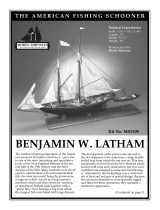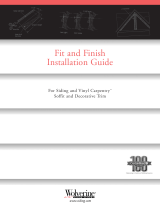Page is loading ...

Billiard Fabric Installation Guide
To assure that optimum performance is obtained we recommend you follow closely these installation
instructions.
ATTACHING CLOTH TO TABLE
When covering tables, first clean the table thoroughly, then check the slate for level and shim where required.
Make sure the screws are fully tightened. Then grout the joints with a flexible filler such as beeswax. Do not use
paraffin or plaster of paris.
1. Leave only enough cloth for one end of slate and one side
(location 1) to allow stapling into the wood frame in 3 places,
approximately 2" apart.
2. Stretch cloth tightly across table and staple three places at
(location 2) 2" apart.
3. Stretch the cloth tightly from (1) to (3) and staple three places
into wood frame 2" apart.
4. Stretching cloth tightly across table from (3) and pulling from
(2), staple two places at (4).
5. Stretch cloth tightly from (1) toward side pocket (5) and staple
three places.
6. Repeat step 5, stretching from from location (3) and staple at
location (6).

7. Stretch cloth tightly across the table from (5) and toward side
pocket (7) from (2) and staple at location (7).
8. Repeat step 7, stretching cloth from (6) and toward the side
pocket at (8).
NOTE: At the side pockets there may be a small pucker at the
center. This will disappear in step 17.
9. At (9), cut a short slit in cloth at the edge - centered on the side
pocket opening. Grasp cloth firmly above the slit, pull the cloth
in to the side pocket opening and staple to the underside of the
frame while working out any wrinkles.
10. Stretching cloth tightly across the table from (9), repeat above
step at (10).
11. Staple cloth at (11) leaving a little slack at the corner
pocket opening.
12. Pull cloth tightly from (11) to (12) and staple three places
at (12).
13. Stretch cloth tightly from (11) to (13) and staple on
approximately 3" centers.
14. Stretch cloth tightly from (12) and (13) toward (14), and staple
in three places at (14).
15. Staple cloth on approximately 3" centers on each side (1)
and (3).
16. Stretch balance of the cloth across the table from (11) to (12)
and staple.

17. Stretch cloth tightly down the length of the table from location
(15) assuring that the slight pucker at the side of the pockets has
disappeared - staple securely.
18. Stretch cloth tightly across the table at each side of the center
pockets and staple on approximately 3" centers.
19. Stretch the cloth into the corner pockets and staple to the
underside of the slate frame. If necessary cut short slits in the
edge of the cloth to assure there are no wrinkles.
20. Trim off all excess cloth around the table.
ATTACHING CLOTH TO RAILS
Corner Pockets:
1. Place new cloth over rail with "face" side down. The cloth
should have an equal over-hang at each end of the rail and
extend approximately 1/2" over the featherstrip groove on the
cushion side (as shown in figure 1).
figure 1
2. Starting at the center of the rail, tap the featherstrip down to
within 1/16" above the rear side of the featherstrip (Figure 1).
3. Stretching the cloth tightly from the center toward the ends, tap
the feather strip down to 1/16" while maintaining the half inch

over-hang to within approximately 3" from ends of the
featherstrip.
figure 2
4. At each end of the featherstrip pull the cloth toward rubber
cushion an additional 1/2" toward the cushion then tap the
featherstrip down (Figure 2).
figure 3
5. Trim the cloth on the cushion side of the featherstrip along the
entire length of the featherstrip with a sharp knife as shown in
Figure 3.
figure 4
6. Tap the entire length of the featherstrip flush with the top of rail
at the rear side of the featherstrip (Figure 4). Never try to tap the
feather strip flush with just a hammer as you will dent the rail
surface behind the featherstrip.

figure 5
7. Turn the rail over and at the corner pockets fold the cloth over
the mitered edge as shown in Figure 5, stretching the cloth
tightly and working out the wrinkles as you staple in the area
shown in Figure 5.
figure 6
8. Pulling the cloth tightly over the rear edge of the pocket facing,
staple three places at Figure 6, location X.
9. If the rail is an end rail repeat step 8 at the other end of the rail.
Then starting at the center of the rail stretch the cloth tightly
over the cushion and staple at the center on the bottom of the
rail - working toward each end (Figure 6).
10. Trim any excess cloth from the bottom of the rail (Figure 7).
Side Pockets:
11. At the side pocket, stretch the
cloth tightly over the nose of
the cushion and staple in three
places as shown in Figure A.
12. Slit the cloth up to the edge of
the cushion nose as shown in
Figure B, then firmly pull the
small strip to the rear of the
pad.

13. Hold the small fold in place
with your thumb and
forefinger and firmly fold it
down over the facing. Now
staple at the rear of the facing
and at the bottom of the rail
as shown in Figure C.
14. Trim excess cloth as required.

REPLACING CUSHION CLOTH (Pocket Tables)
A. Preparing Old Rails
1. After removing the rails from the table, remove the staples from
the ends of the rails at the rear edge of the pocket facing
figure 1-A figure 1-B
2. Cut the old cushion cloth along the full length of featherstrip on
the cushion side (approximately 1/2" from the cloth line) as
shown in figure 1A.
3. Peel the cloth down and insert a featherstrip puller or flat blade
screwdriver (not over 1/8" wide) beneath the featherstrip (as
shown in Figure 1B), and carefully pry the featherstrip out of the
groove. If the featherstrip is undamaged save it for reuse. Turn
rail face side down and remove the staples from the old cloth.
figure b
B. Installing Featherstrips
1. If installing new featherstrips, place the featherstrip in the
groove as shown in Figure B and trim one end flush with the
angle of the pocket opening with a hacksaw. Be careful to keep
the blade tilted at a sufficient angle so you don't cut into the rail
pocket area behind the featherstrip.
2. With one end trimmed, place that end down in to the featherstrip
groove and "butt" it flush against the pocket facing - then trim
the other end in the same manner.

3. Place the new cloth over the featherstrip groove and check to
see if the featherstrip will tap down into the groove. If the cloth
is of heavier grade the featherstrip may require planing as shown
in Figure C.
The groove in the top rail and the featherstrip are cut for lighter
grade cloth. To allow for a full range of cloth grades, removing
material from the featherstrip may be required.
C. Attaching Cloth - Pocket Tables
Corner Pockets
figure 1
1. Place the new cloth on the rail with the nap side down. With the
nap of the cloth from the left to the right on the end rails, or
from designated head to foot of the table on side rails. The cloth
should have an equal amount of overhang at both ends of the rail
and extend 1/2" over the featherstrip groove on the cushion side
as shown in Figure 1.
figure 2
2. Except for approximately 3" at the end of the rail, tap the
featherstrip down with the tapping block and hammer as shown
in Figure 2.
3. At each end of the rails pull the cloth toward the rubber cushion
an additional 3/4" then tap the remainder of the featherstrip
down (Figure 2).

figure 3
4. Trim the cloth on the cushion side of the featherstrip along the
total length of the featherstrip as shown in Figure 3.
figure 4
5. Fold the cloth down over the front of the rail then use your
thumb and forefinger as a guide along the front edge of the
cushion to keep the tapping block at the rear edge of the
featherstrip - tap the featherstrip down flush with the rail surface
as shown in Figure 4.
Never try to tap a featherstrip flush with just a hammer as it will
certainly dent the rail surface behind the feather strip.
figure 5
6. Turn the rail over and at the corner pockets fold the cloth over
the mitered edge as shown in Figure 5. Stretch the cloth tightly,
work out any wrinkles as you staple three places in the area
shown in Figure 5.

figure 6
7. Staple three places along the rear edge of the pocket facing ("X"
in Figure 6), then trim off the superfluous cloth at the pocket
area.
8. If the rail is an end rail repeat Step 7 at the other corner pocket
then, starting at the center of the rail, stretch the cloth tightly
over the cushion and staple at the bottom of the rail working
toward each end (Figure 6).
figure 7
9. Trim the excess cloth from the bottom of the rail as shown in
Figure 7 flush with the edge of the cloth relief groove.
Side Pockets
10. At the side pocket stretch the
cloth tightly over the nose of
the cushion and staple in three
places as shown in Figure A.
11. Slit the cloth up the edge of
the cushion nose as shown in
Figure B, then firmly pull the
small strip (Figure B) to the
rear of the cushion and staple
at the rear of the facing.

12. Hold the small fold in place
with your thumb and
forefinger and firmly fold it
down over the facing at the
bottom of the rail as shown in
Figure C.
13. Trim any excess cloth as required.
/






